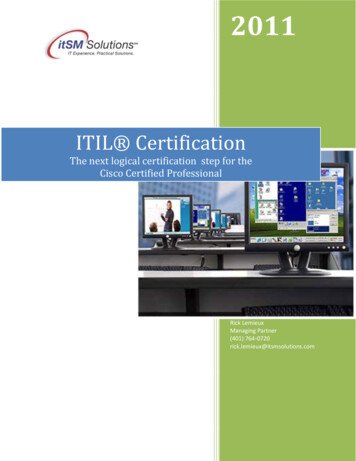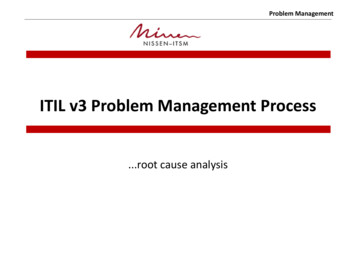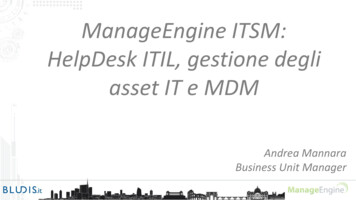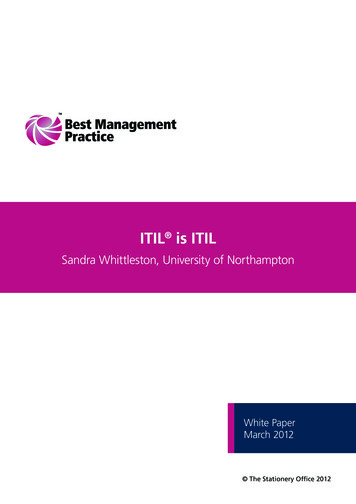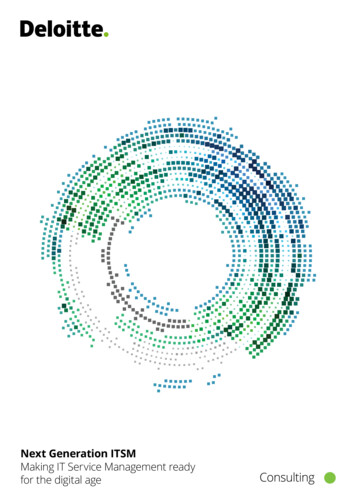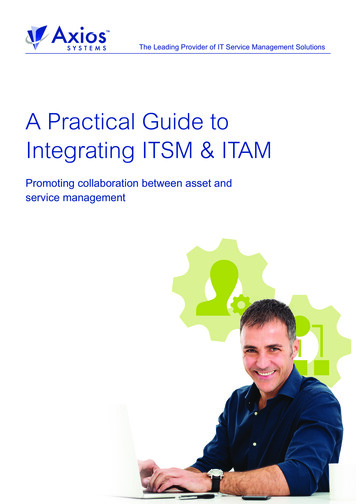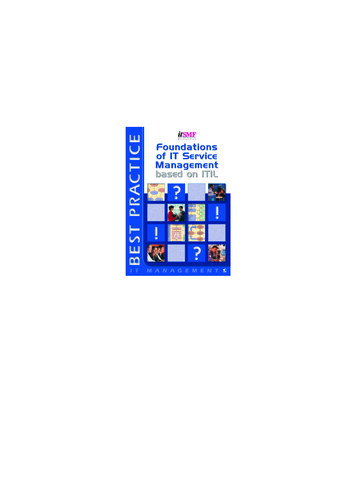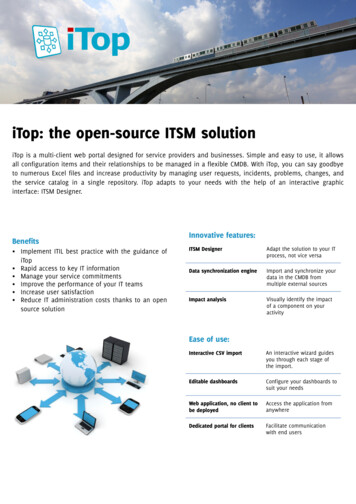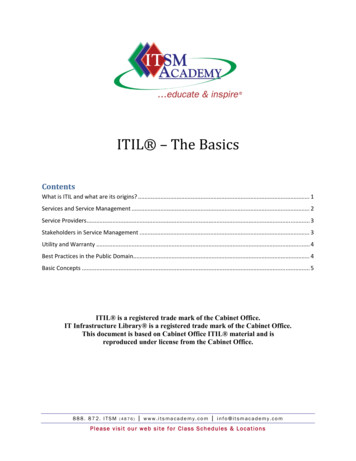
Transcription
ITIL – The BasicsContentsWhat is ITIL and what are its origins? . 1Services and Service Management . 2Service Providers . 3Stakeholders in Service Management . 3Utility and Warranty . 4Best Practices in the Public Domain. 4Basic Concepts . 5ITIL is a registered trade mark of the Cabinet Office.IT Infrastructure Library is a registered trade mark of the Cabinet Office.This document is based on Cabinet Office ITIL material and isreproduced under license from the Cabinet Office.888. 872. ITSM(4876) www.itsmacademy.com info@itsmacademy.comPlease visit our web site for Class Schedules & Locations
ITIL – The BasicsWhat is ITIL and what are its origins?The IT Infrastructure Library (ITIL) is the most widely adopted framework for IT service management inthe world. Simply put, ITIL is a set of books that provide best practice guidance to service providers on: The provision of quality IT servicesThe processes, functions and capabilities needed to support those servicesIn the early 80’s, the UK’s Office of Government Commerce recognized that utilizing consistent practicesfor all aspects of a service lifecycle could assist in driving organizational effectiveness and efficiency aswell as predictable service levels. Thus, ITIL was born. Now in its third edition, ITIL guidance continues tobe a successful mechanism to drive consistency, efficiency and excellence into the business of managingIT services.ITIL is used by many hundreds of organizations around the world and offers best‐practice guidanceapplicable to all types of organizations. ITIL is not a standard that has to be followed word‐for‐word; it isguidance that should be read, understood, and then used to create value for the service provider and itscustomers. Organizations are encouraged to adopt ITIL best practices and to adapt them to their specificenvironments in ways that meet their needs.ITIL Core consists of five lifecycle publications that each provides part of the guidance necessary for anintegrated approach as required by ISO/IEC 20000. ISO/IEC 20000 is the international standard for ITservice management. The five publications are: ITIL Service Strategy – defines the perspective, position, plans and patterns that a serviceprovider must execute to meet an organization’s business outcomesITIL Service Design – designs IT services and the governing IT practices, processes and policiesto realize the service provider’s strategyITIL Service Transition – ensures that new, modified, retired or transferred services meet theexpectations of the businessITIL Service Operation – coordinates and carries out the activities and processes required todeliver and manage services at agreed levels to business users and customersITIL Continual Service Improvement – aligns IT services with changing business needs byidentifying and implementing improvementsThe core publications are expected to provide structure, stability and strength to service managementcapabilities, with durable principles, methods and tools. This serves to protect investments and providethe necessary basis for measurement, learning and improvement.Complementary ITIL publications provide flexibility to implement the core in a diverse range ofenvironments such as specific industry sectors, organization types, operating models and technologyarchitectures.ITIL - TheBasics V2011 R1 0.Docx Page 1
ITIL – The BasicsITIL Core is built around a service lifecycle. Each stage of thelifecycle exerts influence on the others and relies on them forinputs and feedback. This constant set of checks and balancesensures that services are adapted as business needs change andthat services are measured in terms of the value the businessderives from those services.Since ITIL is an approach to IT ‘service’ management, the conceptsof services and service management must be discussed.Services and Service ManagementA service is a means of delivering value to customers by facilitating the outcomes customers want toachieve without the ownership of specific costs and risks. Services facilitate outcomes, or results, byenhancing the performance of tasks and by reducing the effect of constraints. These constraints mayinclude regulatory controls, lack of funding or capacity, or technology limitations.An IT service is a service provided by an IT service provider. A service provider is an organization thatsupplies services to one or more internal or external customers. An IT service is made up of acombination of information technology, people and processes.IT has traditionally been focused on managing technology silos and on delivering infrastructure servicessuch as hardware, network and other data center components. ITIL suggests a more holistic approach tomanaging services from end‐to‐end. This is because the use of IT has become the utility of business.Business today wants IT services that behave like other utilities such as water, electricity or thetelephone. Simply having the best technology will not ensure that IT provides utility‐like reliability.Professional, responsive, value‐driven service management is what brings this quality of service.The more mature a service provider’s capabilities are, the greater its ability to consistently producequality services that meet the needs of itscustomer in a timely and cost‐effective manner.Service management is a set of specializedorganizational capabilities for providingvalue to customers in the form of services.The act of transforming capabilities and resourcesinto valuable services is at the core of servicemanagement. Without these capabilities, a serviceorganization is merely a bundle of resources thathave relatively low intrinsic value for customers.Service management is also a professional practice supported by an extensive body of knowledge,experience and skills. A global community of individuals and organizations in the public and privatesectors fosters its growth and maturity. Formal schemes exist for the education, training andcertification of practicing organizations and individuals. Industry best practices, academic research andformal standards contribute to and draw from its intellectual capital.ITIL - TheBasics V2011 R1 0.Docx Page 2
ITIL – The BasicsIT service management (ITSM) is the implementation and management of quality IT services that meetthe needs of the business. IT service management is performed by IT service providers. A goodrelationship between an IT service provider and its customers relies on the customer receiving an ITservice that meets its needs, at an acceptable level of performance and at a cost that the customer canafford. The IT service provider needs to work out how to achieve a balance between these three areas,and communicate with the customer if there is anything that prevents it from being able to deliver therequired IT service at the agreed upon level of performance or price.A service level agreement is used to document agreements between an IT service provider and acustomer. A service level agreement (SLA) describes the IT service, documents service level targets, andspecifies the responsibilities of the IT service provider and the customer. A single agreement may covermultiple IT services or multiple customers.Service ProvidersThere are three main types of service providers. While most aspects of service management applyequally to all types of service providers, others aspects such as customers, contracts, competition,market spaces (i.e., exploitable opportunities), revenue and strategy take on different meaningsdepending on the specific type. The three types are: Type I – internal service provider – embedded within a business unitType II – shared services unit – provides shared IT services to more than one business unitType III – external service provider – provides IT services to external customersMany organizations have a combination of IT service providers. For example, in a single organization it ispossible that some IT units are dedicated to a single business unit, others provide shared services, andyet others have been outsourced or depend on external service providers.Stakeholders in Service ManagementA stakeholder is a person who has an interest in an organization, project, IT service, etc. Within a serviceprovider organization, there are many different stakeholders including the functions, groups and teamsthat deliver services. There are also stakeholders external to the service provider organization, such as: Customers – who buy goods or services. The customer of an IT service provider is the person orgroup who defines and agrees upon the service level targets. This term is also sometimes usedinformally to mean user. For example, ‘This is a customer‐focused organization.’Users – use services on a day‐to‐day basis. Users are distinct from customers, as somecustomers do not use the IT service directly.Suppliers – third parties responsible for supplying goods or services that are required to deliverIT services. Examples include hardware and software vendors, network and telecom providers,and outsourcing organizations.ITIL - TheBasics V2011 R1 0.Docx Page 3
ITIL – The BasicsInternal customers work in the same organization as the IT service provider. External customers workfor other organizations. Many IT organizations who traditionally provided services only to internalcustomers, now find that they are dealing directly with external customers because of the onlineservices that they provide.Utility and WarrantyThe value of a service can be defined as the level to which that service meets a customer’s expectations.Services contribute value to an organization only when their value is perceived to be higher than thecost of obtaining the service. From the customer’s perspective, value consists of achieving businessobjectives. The value of a service is created by combining two primary elements: utility and warranty.Utility (fitness for purpose) is the functionality offered by a product or service to meet a particular need.Utility can be summarized as ‘what the service does’ and can be used to determine whether a service isable to meet its required outcomes. For example, a service that enables a business unit to processorders should allow sales people to access customer details, stock availability, shipping information, etc.Any aspect of the service that improves the ability of sales people to process sales orders would beconsidered utility. Utility can therefore represent any attribute of a service that removes, or reduces theeffect of, constraints on the performance of a task.Warranty (fitness for use) is an assurance that a product or service will meet its agreed uponrequirements. This may be a formal agreement such as a service level agreement or contract, or amarketing message or brand image. Warranty refers to the ability of a service to meet customers’ needsin terms of availability, capacity, continuity, and security. Warranty can be summarized as ‘how theservice is delivered.’Customers cannot benefit from something that is fit for purpose but not fit for use, and vice versa. Thevalue of a service is therefore only delivered when both utility and warranty are designed and delivered.Best Practices in the Public DomainIn an effort to be more competitive and better meet their customers’ needs, organizations oftenbenchmark themselves against their peers and seek to close gaps in their capabilities. One way to closesuch gaps is the adoption of widely‐used industry best practices. Sources for best practice include publicframeworks, standards and the proprietary knowledge of organizations and individuals. Proprietaryknowledge – also known as ‘tribal knowledge’ – is often deeply embedded in organizations and can becustomized to the point of being idiosyncratic. Because such tacit knowledge is often poorlydocumented, it can be difficult to adopt, replicate or even transfer from one party to another.Publicly available frameworks and standards such as ITIL, Lean, Six Sigma, COBIT, CMMI, PRINCE2,PMBOK , ISO 9000, ISO/IEC 20000 and ISO/IEC 27001 are validated across a diverse set of environmentsand situations rather than the limited experience of a single organization.ITIL - TheBasics V2011 R1 0.Docx Page 4
ITIL – The BasicsIgnoring public frameworks and standards can needlessly place an organization at a disadvantage.Organizations should cultivate their own proprietary knowledge on top of a body of knowledge based onpublic frameworks and standards. Collaboration and coordination across organizations become easierwhen shared practices and standards are in place.Basic ConceptsAssets, Resources and CapabilitiesThe relationship between a service provider and its customers revolves around the use of assets – boththose of the service provider and those of the customers.An asset is any resource or capability. Capabilities representan organization’s ability to coordinate, control and deployresources to produce value. Capabilities are typicallyexperience‐driven, knowledge‐intensive, information‐basedand firmly embedded within an organization’s people,systems, processes and technologies. It is relatively easy toacquir
ITIL – The Basics ITIL - The Basics V2011 R1 0.Docx Page 5 Ignoring public frameworks and standards can needlessly place an organization at a disadvantage. Organizations should cultivate their own proprietary knowledge on top of a body of knowledge based on

